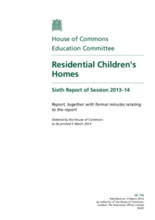Summary
In June 2013, the Government announced a set of proposals to reform the regulation of children’s residential care in England. The Government is addressing the main challenges facing the sector and overall its reforms should noticeably strengthen the safety and welfare of children living in residential homes. However, we heard some concerns expressed about these reforms and, inevitably, our report concentrates on the areas of concern.
The Government needs to consider residential care in the context of the wider care system, rather than in isolation. This involves looking across the different types of care and the child’s journey before, during and after care. Placement stability is a crucial factor in determining positive outcomes for children in residential care and the Government must address the factors that lead to placement instability and breakdown in a wider programme of reform.
A national strategy for care provision based on better assessments of need would benefit children in care and the sector more generally, as well as making the most efficient use of resources. The Government should work towards developing such a strategy.
The current package of reforms focuses on amending the rules and guidance governing children’s residential care. The Government needs to ensure that the regulations and guidance that exist are properly implemented and enforced. The wellbeing of looked after children also depends on less tangible factors like the attitudes of care staff and the leadership and culture in children’s homes.
Joined-up working between different organisations has an important role to play in improving outcomes for looked after children. One example is local authorities working together collaboratively in consortia to bring distant out-of-authority placements closer to home, where that meets the child’s needs. Another is collaborative working between children’s homes, local authorities and services in the areas where homes are located. We are concerned that only a minority of respondents to the consultation thought that the Government’s proposals would improve collaboration between these organisations.
It is a matter of great concern to us that there are children’s homes situated in areas where the risk to the safety of young people is increased considerably. The new area risk assessments are intended to assist in identifying where homes are in unsuitable or dangerous locations and preventing children being placed in such homes. Given the importance of this issue, we recommend that the Government closely monitors the impact of the new risk assessments and how they are used and reports back to this Committee within a year. The Government should be prepared to bring forward further reforms if the evidence indicates that current measures are not adequately addressing the problem.
We strongly endorse the view that, except where it is clearly in the interests of that individual child to move out of the area, local authorities should provide a placement as close as possible to the child’s home and that they should have sufficient placements within their own area or that of their neighbouring authorities to fulfil this requirement. We will closely scrutinise the next DfE data pack for an indication of whether the current reforms are having the desired effect in reducing the numbers of children given distant placements. We also recommend that the Government commissions a study of the impact of a rule prohibiting local authorities from placing a child more than 20 miles from home, unless there is a proven need to do so.
The reforms covering children’s homes and the care planning and placement process could be strengthened in a number of ways. These include making provision for the welfare of the children affected when a children’s home goes bankrupt and assessing the role that the planning system might play in ensuring that homes are located in safe areas. We also suggest further changes to help avoid the unnecessary criminalisation of looked after children and to provide children with a greater say on the selection of the care staff that look after them.

